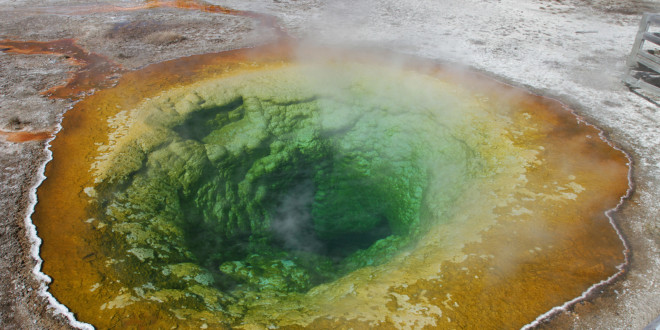Montana State University (MSU) has received $1.8 million from the National Science Foundation to research Yellowstone microbes that subsist on methane.
According to the Bozeman Daily Chronicle, the $1.8M is part of $6M package given the project as a whole, which includes research teams at the South Dakota School of Mines and Technology and the University of Oklahoma. In addition to Yellowstone microbes, researchers will also be studying microbes living in a former South Dakota gold mine. From the Chronicle:
“It’s not well understood what organisms are involved in the conversion of methane in these environments,” said Robin Gerlach, a professor in MSU’s Chemical and Biological Engineering Department.
Methane conversion is of increasing interest because the gas is a potent greenhouse agent whose contribution to climate change is second only to carbon dioxide, Gerlach said. Large amounts of methane are emitted by natural wetlands, agriculture, oil and coal extraction, and landfills. Relatively little is known about the production and conversion of methane deep underground and in other environments once thought uninhabitable to methane-converting microbes called methanotrophs, he added.
The team’s interest was piqued by recent discoveries: MSU scientists measured methane in steam from Yellowstone’s hot pools, and South Dakota School of Mines and Technology researchers found methanotrophs in the former mine, now called the Sanford Underground Research Facility.
“Yellowstone is a huge reservoir of microbial capabilities that we’ve barely explored,” said Brent Peyton, director of MSU’s Thermal Biology Institute. “We’re looking for microbes that are just barely being discovered.”
Other members of the research collaboration echoed Gerlach and Peyton’s enthusiasm. Connie Chang, assistant professor of chemical and biological engineering at MSU, told the Chronicle the array of “different backgrounds and techniques” brought together under the grant has much potential.
Sampling of Yellowstone microbes will begin in the fall. Researchers will then design models to explain the metabolism of these microbes and explore ways to make “biofilms” of them.
Biofilms, described as “cities for microbes,” form in response to environmental conditions. Dental plaque is one example of a biofilm, where microbes form tartar, which contributes to tooth decay and gum disease.
Microbial research is a hot ticket item in Yellowstone National Park, with several projects undertaken each year to “unlock” microbes in order to understand ecosystem dynamics and find new, unconventional applications for microbes, among other research concerns.
 Yellowstone Insider Your Complete Guide to America's First National Park
Yellowstone Insider Your Complete Guide to America's First National Park





